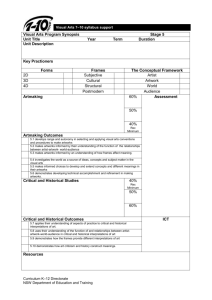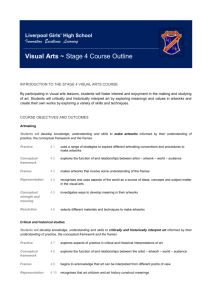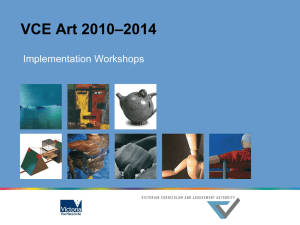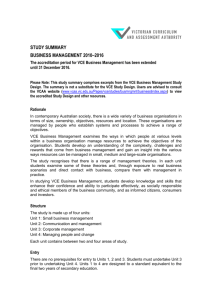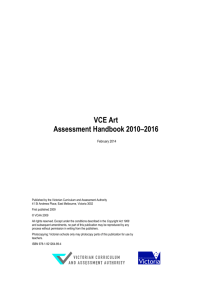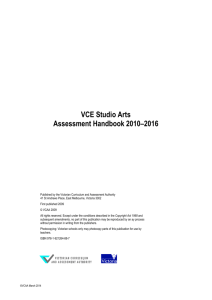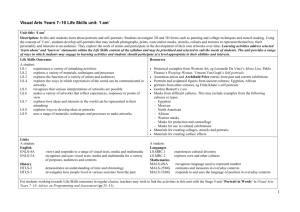Art Study Summary
advertisement
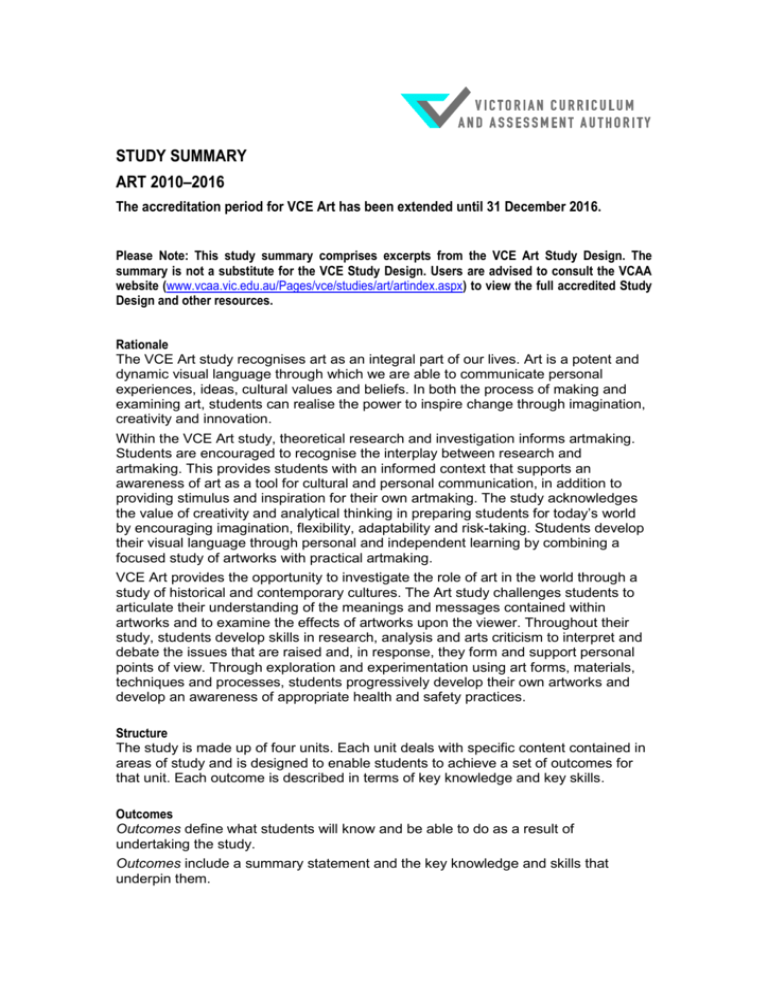
STUDY SUMMARY ART 2010–2016 The accreditation period for VCE Art has been extended until 31 December 2016. Please Note: This study summary comprises excerpts from the VCE Art Study Design. The summary is not a substitute for the VCE Study Design. Users are advised to consult the VCAA website (www.vcaa.vic.edu.au/Pages/vce/studies/art/artindex.aspx) to view the full accredited Study Design and other resources. Rationale The VCE Art study recognises art as an integral part of our lives. Art is a potent and dynamic visual language through which we are able to communicate personal experiences, ideas, cultural values and beliefs. In both the process of making and examining art, students can realise the power to inspire change through imagination, creativity and innovation. Within the VCE Art study, theoretical research and investigation informs artmaking. Students are encouraged to recognise the interplay between research and artmaking. This provides students with an informed context that supports an awareness of art as a tool for cultural and personal communication, in addition to providing stimulus and inspiration for their own artmaking. The study acknowledges the value of creativity and analytical thinking in preparing students for today’s world by encouraging imagination, flexibility, adaptability and risk-taking. Students develop their visual language through personal and independent learning by combining a focused study of artworks with practical artmaking. VCE Art provides the opportunity to investigate the role of art in the world through a study of historical and contemporary cultures. The Art study challenges students to articulate their understanding of the meanings and messages contained within artworks and to examine the effects of artworks upon the viewer. Throughout their study, students develop skills in research, analysis and arts criticism to interpret and debate the issues that are raised and, in response, they form and support personal points of view. Through exploration and experimentation using art forms, materials, techniques and processes, students progressively develop their own artworks and develop an awareness of appropriate health and safety practices. Structure The study is made up of four units. Each unit deals with specific content contained in areas of study and is designed to enable students to achieve a set of outcomes for that unit. Each outcome is described in terms of key knowledge and key skills. Outcomes Outcomes define what students will know and be able to do as a result of undertaking the study. Outcomes include a summary statement and the key knowledge and skills that underpin them. VCE ART 2010–2016 STUDY SUMMARY Only the summary statements of the outcomes have been reproduced below and must be read in conjunction with the key knowledge and skills published in the study design. Unit 1 Outcome 1 On completion of this unit the student should be able to analyse and interpret a variety of artworks using the Formal Framework and the Personal Framework. Outcome 2 On completion of this unit the student should be able to present visual creative responses that demonstrate their personal interests and ideas through trialling techniques, materials and processes. Unit 2 Outcome 1 On completion of this unit the student should be able to analyse, interpret, compare and contrast artworks from different cultures using the Formal Framework and the Cultural Framework. Outcome 2 On completion of this unit the student should be able to demonstrate technical and artistic development in the presentation of visual responses that include one finished artwork, through the exploration of selected media, materials and techniques. Unit 3 Outcome 1 On completion of this unit the student should be able to use the Analytical Frameworks to analyse and interpret artworks produced before 1970 and artworks produced since 1970, and compare and contrast the meanings and messages of artworks produced before 1970 with those of artworks produced since 1970. Outcome 2 On completion of this unit the student should be able to explore personal ideas and concepts through a conceptual and practical investigation including at least one finished artwork, using selected Analytical Frameworks to reflect upon and annotate their work. Unit 4 Outcome 1 On completion of this unit the student should be able to discuss and debate an art issue using selected artist/s works as context, and present their informed opinion with reference to artworks and with the support of selected commentaries and relevant aspects of the Analytical Frameworks. Outcome 2 On completion of this unit the student should have progressively communicated ideas, directions and/ or personal concepts in a body of work that includes at least one finished artwork, having used selected Analytical Frameworks to underpin reflections on their artmaking. ©VCAA February 2014 2 VCE ART 2010–2016 STUDY SUMMARY Entry There are no prerequisites for Units 1, 2 and 3. Students must undertake Unit 3 prior to undertaking Unit 4. Assessment Satisfactory Completion Demonstrated achievement of the set of outcomes specified for the unit. Levels of Achievement Units 1 and 2 Individual school decision on levels of achievement. Units 3 and 4 School-assessed Coursework, School-assessed Task, and an end-of-year examination: Units 3 and 4 School-assessed Coursework: 20 per cent Units 3 and 4 School-assessed Task: 50 per cent Units 3 and 4 examination: 30 per cent. ©VCAA February 2014 3

